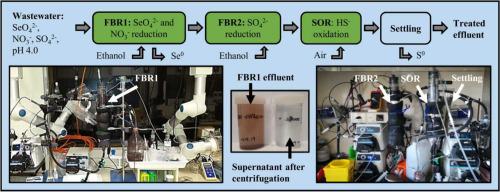Journal of Hazardous Materials ( IF 12.2 ) Pub Date : 2021-10-19 , DOI: 10.1016/j.jhazmat.2021.127539 Su Yan 1 , Ka Yu Cheng 2 , Maneesha P Ginige 3 , Christina Morris 3 , Xiao Deng 4 , Jian Li 5 , Shaokun Song 3 , Guanyu Zheng 6 , Lixiang Zhou 6 , Anna H Kaksonen 7

|
Bioreduction can facilitate oxyanions removal from wastewater. However, simultaneously removing selenate, nitrate and sulfate and recovering high-purity elemental selenium (Se0) from wastewater by a single system is difficult and may lead to carcinogenic selenium monosulfide (SeS) formation. To solve this issue, a two-stage biological fluidized bed (FBR) process with ethanol dosing based on oxidation-reduction potential (ORP) feedback control was developed in this study. FBR1 performance was first evaluated at various ORP setpoints (between −520 and −360 mV vs. Ag/AgCl) and elevated sulfate concentration. Subsequently, ethanol-fed FBR2 was used to reduce sulfate from FBR1 effluent, followed by an aerated sulfide oxidation reactor (SOR). At − 520 mV ≤ ORPs ≤ − 480 mV, FBR1 removed 100 ± 0.1% nitrate and 99.7 ± 0.3% selenate without sulfate reduction. At ORPs ≥ − 440 mV, selenate reduction was incomplete, whereas nitrate removal remained stable. Se0 recovery efficiency from FBR1 effluent was 37.5% with 71% Se purity. FBR2 converted 86% of the remaining sulfate in FBR1 effluent to hydrogen sulfide, but the over-oxidation of dissolved sulfide in SOR decreased the overall sulfate removal efficiency to ~46.3%. Overall, the two-stage FBR process with ORP feedback dosing of ethanol was effective for sequentially removing selenate, nitrate and sulfate and recovering Se0 from wastewater.
中文翻译:

在具有氧化还原电位反馈控制的多级生物反应器过程中顺序去除硒酸盐、硝酸盐和硫酸盐并回收元素硒
生物还原可以促进从废水中去除含氧阴离子。然而,通过单一系统同时去除硒酸盐、硝酸盐和硫酸盐以及从废水中回收高纯度元素硒(Se 0)是困难的,并且可能导致致癌的一硫化硒(SeS)的形成。为了解决这个问题,本研究开发了一种基于氧化还原电位(ORP)反馈控制的乙醇投加两阶段生物流化床(FBR)工艺。FBR1 性能首先在各种 ORP 设定点(-520 和 -360 mV 与 Ag/AgCl 之间)和升高的硫酸盐浓度下进行评估。随后,乙醇进料的 FBR2 用于减少 FBR1 流出物中的硫酸盐,然后是充气硫化物氧化反应器 (SOR)。在 − 520 mV ≤ ORPs ≤ − 480 mV,FBR1 去除了 100 ± 0.1% 的硝酸盐和 99.7 ± 0.3% 的硒酸盐,没有硫酸盐还原。在 ORP ≥ - 440 mV 时,硒酸盐还原不完全,而硝酸盐去除保持稳定。FBR1 流出物中的Se 0回收率为 37.5%,Se 纯度为 71%。FBR2 将 FBR1 流出物中 86% 的剩余硫酸盐转化为硫化氢,但 SOR 中溶解的硫化物的过度氧化将整体硫酸盐去除效率降低至 ~46.3%。总体而言,具有ORP反馈加料乙醇的两级FBR工艺对于顺序去除硒酸盐、硝酸盐和硫酸盐以及从废水中回收Se 0是有效的。










































 京公网安备 11010802027423号
京公网安备 11010802027423号